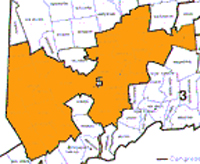| Connecticut’s Political Lineup
|
Redistricting Deadline The deadline is Sept. 15, 2001; if this deadline is not met, a commission must submit a plan by Nov. 30, 2001. | Who’s in Charge of Redistricting? The legislature has the responsibility for both state legislative and congressional districting. If they fail to meet the deadline, the governor appoints a nine-member redistricting commission. The Governor has no veto power over redistricting at either the congressional or state legislative levels. | ||||||||||||||||||||||||
Districting Principles
| Public Access The joint committee will hold a series of public hearings in each congressional district and several in Hartford. Any member of the public may submit a plan to the committee, and a public viewing station is available on the capitol grounds which graphically displays all plans submitted to the committee for consideration. *The new maps for Connecticut's state Senate and House of Representatives are now available online.* | ||||||||||||||||||||||||
Political Landscape Since reforms in the 1970s, house and senate leaders have been required to appoint two members from each of the four legislature caucuses to a joint Reapportionment Committee in the February after the census year. Unlike most states, the eight-member committee is required to introduce a redistricting plan as a "joint resolution,” which is the means to effectively nullify gubernatorial veto power. If the joint committee fails to pass a joint resolution with a 2/3 vote of the legislature by its constitutional deadline, the committee is disbanded and a nine-member commission is formed by the Governor. Although not required, generally the commission is made up of the members on the joint committee; however, the ninth member is usually a retired legislator. The last person to hold this 'tiebreaking' position insisted that he would not vote until eight members of the commission told him to vote for the same plan. Thus, consensus appears to be an informal objective. Connecticut lost a House seat after federal reapportionment in 2001, which easily could lead to two incumbents having to face one another. | Legal Issues Last decade’s state legislative district plan was challenged on the basis that it violated state constitutional requirements by creating house districts that divided towns. The challenge was unsuccessful. The court explained that the plaintiffs made no showing that towns were divided for reasons other than the need to satisfy the equal population requirement. | ||||||||||||||||||||||||
Legislation/Reform Efforts There apparently have been no major reform efforts since the state constitutional amendments regarding the committee's and commission's deadlines, which were instituted in the 1970s. |
|
Contact Information D'Ann Mazzocca Dan Duffy |

